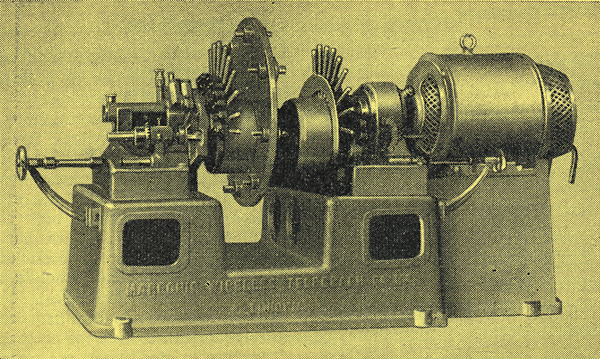|
Ever since the Imperial wireless scheme had been announced the Government had been constantly under criticism, mainly on the grounds that the contract had not been thrown open to tender. A technical committee was now appointed 'to report on the merits of the existing systems of long-distance wireless telegraphy'. The distinguished members, all Fellows of the Royal Society, included the Director of the NPL and the President of the IEE They obviously did a conscientious job and produced a report providing a valuable and unbiased commentary on the state of the art in 1913. The systems examined were Marconi and Telefunken (spark), Poulsen (arc) and Goldschmidt (alternator), which used a rotary RF generator with contra-rotating field and armature, frequency multiplication being obtained by feedback. Those responsible for these systems were invited to give practical demonstrations 'if possible over distances of 2,000 miles and upwards'.

Disc discharger for the 75kW Marconi spark installation
According to the committee's report 'Except in the case of the Marconi system we did not, however, obtain any demonstrations over a distance of even 1,000 miles'. Of Telefunken, it was said that experiments were being made between Nauen and Togoland (4,000 miles) and that communication seemed possible at night. Results of the Poulsen arc system working between San Francisco and Honolulu (2,100 miles) 'do not appear to have been very satisfactory'. The Goldschmidt machine being set up at Hannover 'was admirable both in design and workmanship' and expected to be capable of communicating across the Atlantic.
The Clifden transatlantic station was visited by the committee members, to whom high-speed and duplex working were successfully demonstrated. Of the general performance, it was said 'Communication is practically continuous, though there are, no doubt, periods when the signals become very weak and even occasional periods when no signals can get through'. But a note of warning was wisely sounded about the possibilities of atmospheric interference in the tropics.
In spite of this favourable report, the Imperial wireless scheme was not to have a smooth passage. Criticism of the Government continued, and a political scandal had developed. To cut a long story short, although the contract was eventually ratified by Parliament, the scheme never came to fruition. It ended with the conferring of the GCVO on Marconi and the award to his company, many years later, of £590,000 damages against the Postmaster-General for breach of contract.
Thanks to the attention focused on Wireless by the Titanic disaster the amateur movement had begun, and we were already publishing instructional articles for the benefit of amateur readers. We showed them it was quite easy to make a start: 'An old motor-cycle ignition coil will do for the transmitter and a simple crystal set for the receiver'. American amateurs were now controlled, being restricted to wavelengths below 200m and input powers of not more than 1kW.
|